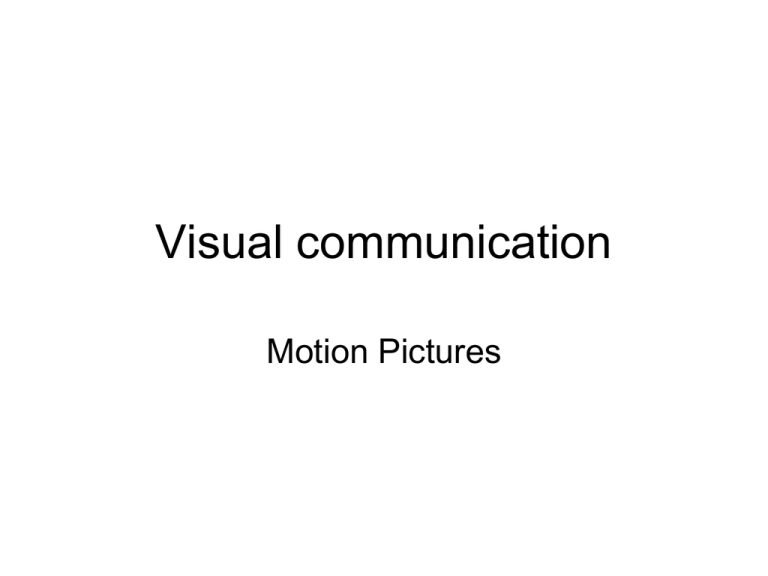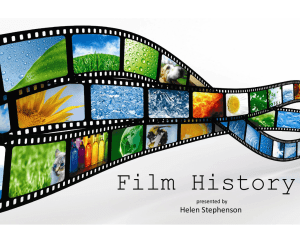MOVIES
advertisement

Visual communication Motion Pictures Motion pictures • “Movies” - a term for motion pictures that are produced primarily for entertainment. i.e. Hollywood • “Films” – motion pictures that are primarily non-fiction or “art” films. i.e. documentaries, biographies, foreign and independent films Technical background • • • • The illusion of movement Persistence of vision Still images projected in rapid succession Frame rate = the number of still pictures projected per each second to create the illusion of constant fluid motion • Flicker (critical fusion) rate = the number of frames required each second to eliminate visible flicker Frame rates • Original motion pictures were based on a frame rate of sometimes 12-16 frames per second – Images appeared jerky with noticeable flicker • 12 frames per second (fps) is the minimum to create the illusion of seamless motion • 18 (fps) is the minimum to avoid flicker Frame rates • “Home movie” formats (8 millimeter) used 18 fps • Commercial films use 24 fps • Television uses 30 fps • In modern motion pictures, the shutter projects each frame twice to reduce flicker History • Persistence of vision (animation) first demonstrated by Eadweard Muybridge • Muybrigde was settling a bet on whether all 4 of a horse’s left the ground at any point in its gallop • Arranged a series of still cameras along the track with trip wires Zoetrope “Mutoscope” Kinetoscope •Edison invented the kinetoscope •Used Eastman roll film Kinetoscope Mutoscope/kinetoscope • • • • The penny arcade Machines that cost a penny to view Some adult content Edison also developed a projection device based on the kinetoscope called the “kinetograph” • Operated on electricity – Edison’s pet project History • Robert Paul bought the Edison Kinetograph and gave it a crank • This was the first movie camera Lumiere • Lumiere Brothers (French) used the “cinematographe” to both record and show films • Lumiere films were documents of daily life • They exhibited the films at night in the towns and villages where they filmed Thomas Edison • Pioneer filmmaker • Created documents of daily life and simple acts • Also pioneered in fantasy and drama • Edison built a studio on a turntable to make films – turned to make use of sunlight • The “Black Maria” was covered with black tar paper Black Maria Black Maria George Melies • A surrealist - magician and filmmaker • The inventor of special effects – Accidentally discovered the “stop trick” disappearance effect – Pioneered other science fiction effects George Melies Milestones/pioneers • D.W. Griffith – “Birth of a Nation” – The “blockbuster” – Epic drama about the Civil War • Nanook of the North – The first documentary – About an Eskimo Nickelodeon Nickelodeon • Nickel = 5¢ • Odeon = roofed theater • Neighborhood theaters in early 20th century Sound in the movies • Early films were silent – sometimes with live musical accompaniment • RCA Vitaphone system used 78 rpm records synchronized with the silent film • Now film sound is recorded onto the film optically Optical sound - Photophone The movies • Sound helped the industry grow • Studios grew and their control expanded • The movie industry was controlled by a few huge studios that were vertically integrated – Production, talent, distribution, exhibition • United Artists – Mary Pickford, Douglas Fairbanks, Charlie Chaplin – formed as reaction to the big studios Scandals • Sex scandals – Culminating in the Roscoe “Fatty” Arbuckle scandal in which he assaulted a minor • House Un-American Activities Commission – The “Red Scandal” – Joe McCarthy – Blacklist Threats to the movies and how they responded • Radio siphons off audience – Movies introduce color • Technicolor • Television siphons audience – Movies introduce wide screen • Cinerama – 3 cameras • Cinemascope – Panavision – Movies create ornate palaces – Other gimmicks • 3-D, Smell-a-vision, Sensurround Threats… • Color television challenges the movies – Movies respond double features • Giving birth to the “B” movie • Cheap movies to be shown with a big budget movie – Drive ins • Other media still challenge the movies – Surround sound – Cineplex Technical considerations • Film width – 8 mm – home movies – 16 mm – independent and documentary – 35 mm – commercial film production – 70 mm – super wide screen – Imax – 70 mm projected horizontally Technical considerations • Aspect ratio – 5 X 3 = “flat” prints – 16 X 9 = “anamorphic” wide screen – “Cinemascope” Technical considerations • Color • The principle of color photography was introduced by James Clerk Maxwell in the 1800s with additive color • Color in the movies – Hand tinting – Kinemacolor – 2 color process – Technicolor – 3 color process Technical considerations • Early films used hand-cranked cameras • Lighting was not available to allow indoor filming with deep focus • Lens optics did not permit “deep focus” • Early sound films used “blimped” cameras that were extremely large and heavy • The camera did not move – only panned and tilted – and not often Technical considerations • Films are shot “MOS” – silent • Sound is added in post production – Looping – ADR – “automatic dialogue replacement” – Foleying • Sound tracks include dialogue, score and sound effects (Foley) Ratings • The Hays Code – Named for William Hayes former Postmaster General of the United States – The U.S. Motion Picture Production Code • Replaced by the Motion Picture Association of America –G–M–R–X – M replaced by GP – Now G – PG – PG13 – R – NC17 The language of filmmaking • The shot – The basic component of filmmaking – a shot is a continuous strip of motion picture film, created of a series of frames, that runs for an uninterrupted period of time. Shots are generally filmed with a single camera and can be of any duration • Shots are assembled into scenes – Scenes share a common location Issues • Stereotypes in the movies – Racial – Gender – Cultural – Other? Contemporary issues • Foreign Marketing • Product placement • Merging technologies marry film, vide, and computers • Future directions – CGI – Interactivity – ???







